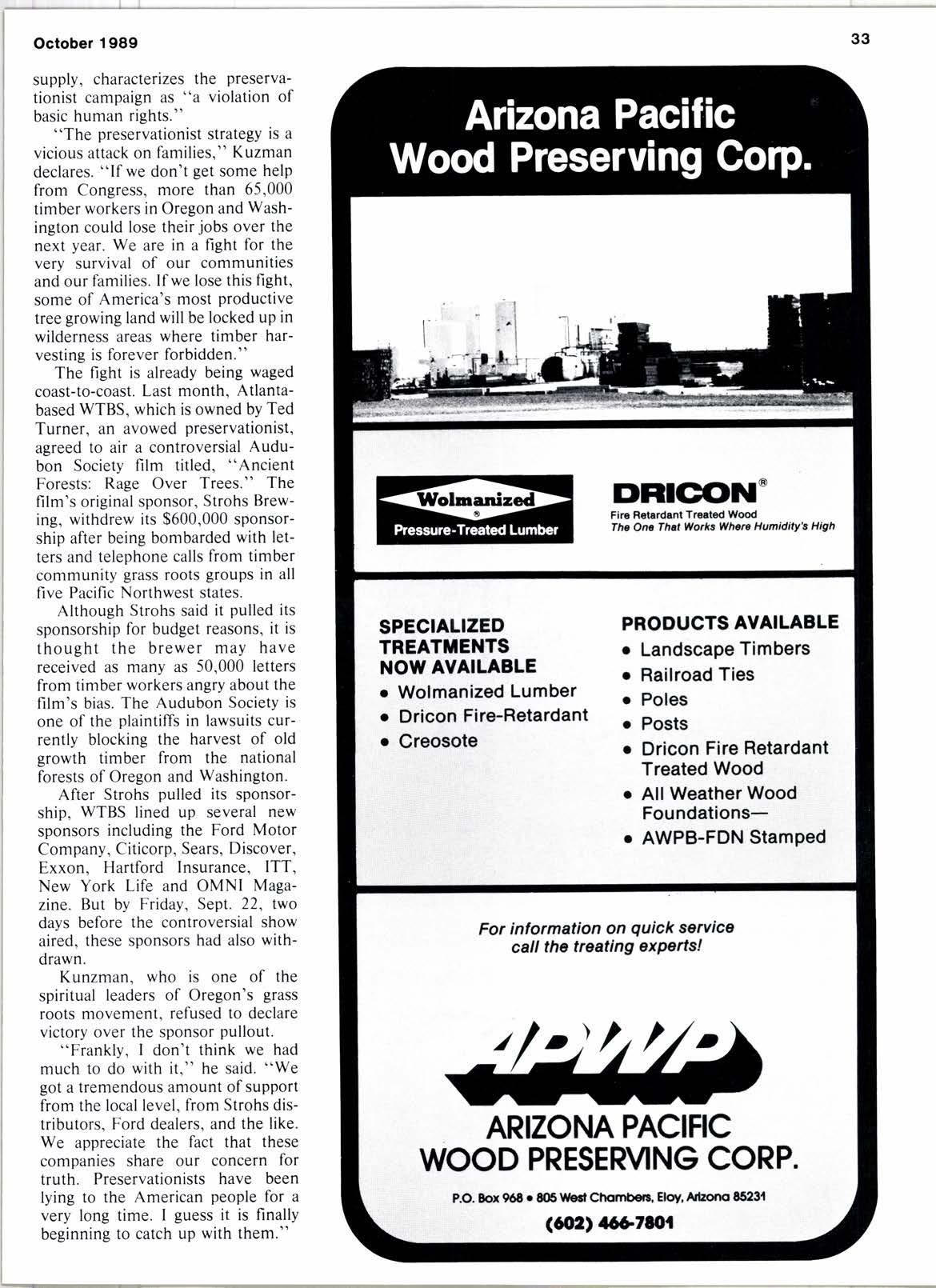
4 minute read
Timber Gommunities Flex Their Muscle
By Jim Petersen
A year ago August, the seeds of a grass roots revolution were sown in Grants Pass, Or., a small, southwest Oregon timber community.
On a hot August afternoon, more than 1,500 logging trucks from five states journeyed there to participate in the Silver Fire Roundup.
Part celebration, part protest, it drew 10,000 cheering timber industry supporters, all of them mad as hell over preservationist efforts to use the federal court system to block the harvest of about 30 million feet of timber killed by the Silver Fire in I 987.
The convoy to Grants Pass attracted national media attention. And well it should have. It remains the largest peacetime convoy in American history. At one point, the line of trucks sitting on the shoulder of Interstate 5 North stretched 42 miles. Many drivers sat in 100degree heat for more than five hours, waiting to exit the freeway.
Editor's Note: Jim Petersen is the editor o/ Evergreen, a publication e/ Southern Oregon Timber Industies Association, Med.fbrd, and Douglas Timber Operarors, Roseburg. To receive a .free subscription, or to learn more about grass roots groups, write Evergreen, 2680 N. Paci/ic Hwy., Medlbrd, Or. 97501.
One by one, each truck rolled passed a makeshift stage at the Josephine County Fair Grounds, to be introduced over the public address system, and to receive meal tickets and a complimentary Silver Fire Roundup cap.
There was not a dry eye in the house.
The grass roots uprising that began on that hot August afternoon has spread like wildfire.
There are now organized grass roots groups in more than half of the 202 timber dependent communities in Oregon, Washington, Idaho,
Montana and California. They possess a kind of raw political power the timber industry's association structure could not have imagined in its wildest sweet dreams.
Make no mistake. These groupsthe Oregon Project, Save Our Sawmills, the Yellow Ribbon Coalition, Communities For A Great Northwestface a long, uphill struggle.
In Oregon and Washington, preservationist lawsuits and timber sale appeals currently block the harvest of more than 2.5 billion board feet of national forest timber. The situation is much the same in other western states, where more than 600/o of all forest land is owned by the federal government. In 1988, 650/o of alltimber harvested in the I I western states came from federal forests.
"Preservationists want to stop all timber harvesting on federal forest lands," declares John Kunzman, president of the Sweet Home, Or., chapter of Communities For A Great Oregon, and co-chairman of the newly formed Oregon Lands Coalition.
Kunzman, co-owner of a logger's supply, characterizes the preservationist campaign as "a violation of basic human rights."
"The preservationist strategy is a vicious attack on families," Kuzman declares. "lf we don't get some help from Congress, more than 65,000 timber workers in Oregon and Washington could lose their jobs over the next year. We are in a fight for the very survival of our communities and our families. If we lose this fight, some of America's most productive tree growing land willbe locked up in wilderness areas where timber harvesting is forever forbidden."
The fight is already being waged coast-to-coast. Last month, Atlantabased WTBS, which is owned by Ted Turner, an avowed preservationist, agreed to air a controversial Audubon Society film titled, "Ancient Forests: Rage Over Trees." The film's original sponsor, Strohs Brewing, withdrew its $600,000 sponsorship after being bombarded with letters and telephone calls from timber community grass roots groups in all five Pacific Northwest states.
Although Strohs said it pulled its sponsorship for budget reasons, it is thought the brewer may have received as many as 50,000 letters from timber workers angry about the film's bias. The Audubon Society is one of the plaintiffs in lawsuits currently blocking the harvest of old growth timber from the national forests of Oregon and Washington.
After Strohs pulled its sponsorship, WTBS lined up several new sponsors including the Ford Motor Company, Citicorp, Sears, Discover, Exxon, Hartford Insurance, ITT, New York Life and OMNI Magazine. But by Friday, Sept. 22, two days before the controversial show aired, these sponsors had also withdrawn.
Kunzman, who is one of the spiritual leaders of Oregon's grass roots movement, refused to declare victory over the sponsor pullout.
"Frankly, I don't think we had much to do with it," he said. "We got a tremendous amount of support from the local level, from Strohs distributors, Ford dealers, and the like. We appreciate the fact that these companies share our concern for truth. Preservationists have been lying to the American people for a very long time. I guess it is finally beginning to catch up with them."

WWPA Prediction: 1.4 million housing starts
Housing starts will finish 1989 at 1.4 million units and 1990 with 1.35 million units, Western Wood Products Association members were told at their fall meeting.
Single family units, which use more lumber, will increase their share from 73% this year to 7 3.50/o in 1990. Total softwood consumption should reach 46.6 billion bf in 1989, but drop to 45.2 billion in 1990. Repair and remodeling markets should increase their consumption of the total to 31.40/o in 1989 and 32.10/o in 1 990.
If log supplies are available, the western lumber manufacturing industry will produce 22.57 billion board feet in 1989 and 22.04 billion board feet in 1990 for the third and fourth highest years in industry history, just under 1987's record 23.9 billion board feet.
"There is a real possibility that lumber demand levels (in 1990), as we know them, could not be met," president H. A. Roberts told the meeting in Tucson, Az., "because legislative and regulatory issues that will [have an] impact [onl federallog supplies are not yet resolved, no attempt has been made to quantify where shortfalls may occur or whether they could be fully offset. Some log shortages have already developed and it is almost certain that










